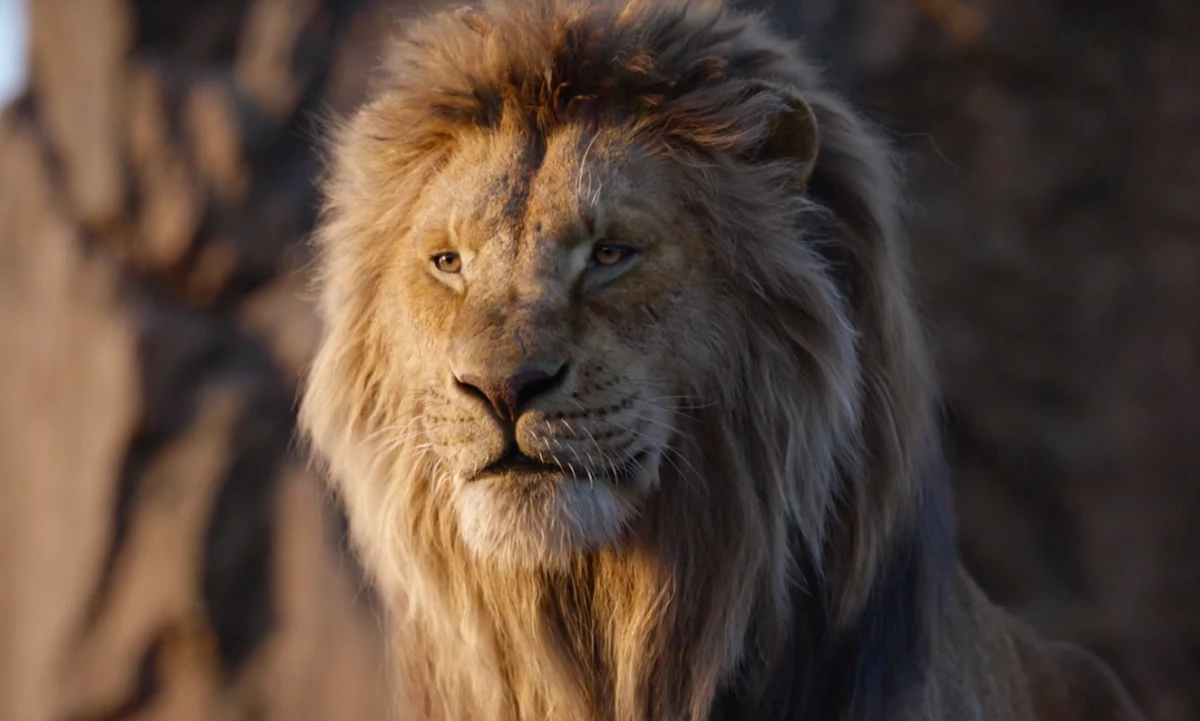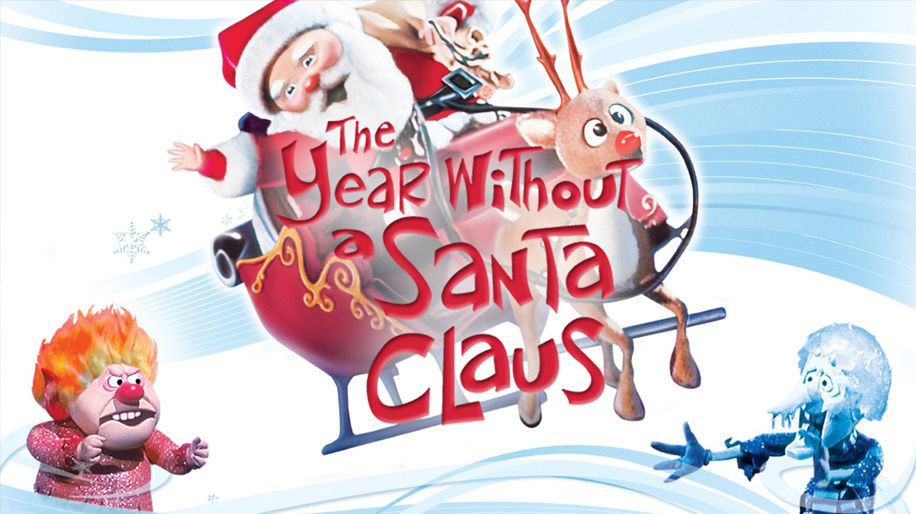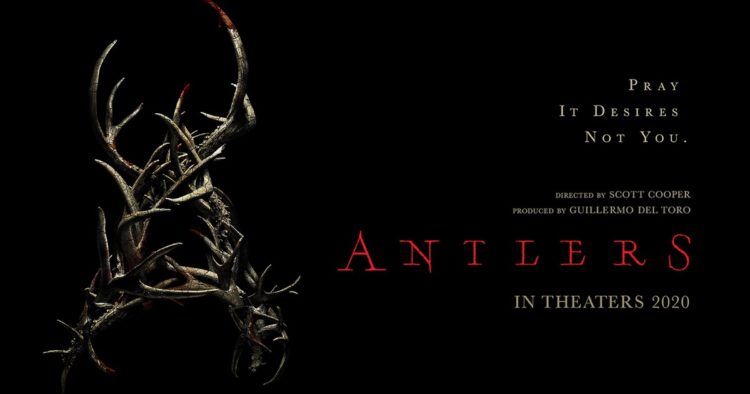Moderated by Steve Weintraub from Collider, the panel featured a trailer for the Horror film ‘Antlers’, and an interview with director Scott Cooper and producer Guillermo del Toro.
Del Toro spoke about the overall message of the film, stating that all the pain and rage incarnate in the movie is like an invocation for the dubious star monster, a Native American legend called the Wendigo, calling it “a metaphor made flesh”.
Del Toro gleefully spoke about the strange intersectionality of his three most influential directors: Disney, Hitchcock, and Spanish-Mexican surrealist Bunuel.
 When asked if they were given a ton of money and could green-light any project, Cooper talked about a script he had written for an Edgar Allen Poe film, and of course, del Toro immediately responded with the Mountains of Madness and Frankenstein. Though del Toro added, he would want to do Frankenstein in a 2 to 3 part story, in order to get all parts of the book, as it changes voices so many times and is a complicated story.
When asked if they were given a ton of money and could green-light any project, Cooper talked about a script he had written for an Edgar Allen Poe film, and of course, del Toro immediately responded with the Mountains of Madness and Frankenstein. Though del Toro added, he would want to do Frankenstein in a 2 to 3 part story, in order to get all parts of the book, as it changes voices so many times and is a complicated story.
Del Toro went on to talk about the filmmaking process, stating that editing is typing with the most expensive typewriter in the whole world. He claimed to be a big believer in the physical medium of DVDs, mentioning he has over 7 thousand of them in his house, likening his collection to when one wants to read Walt Whitman or Ulysses, you go and pull out the physical book and read, or in this case, watch. Del Toro watches all the extras and audio commentary, he said, and explained that by watching your favorite filmmakers closely, their techniques can eventually become a new tool for your tool-belt.
In del Toro’s opinion, the Coen brothers are the best living filmmakers right now, but they’re also the ones who hold the most mystery for fellow filmmakers. Del Toro served as a juror for them at the Cannes film festival, and interviewed them whenever he got the chance, and rhapsodized about their filmmaking instincts being all their own.
Cooper talked about the overlying themes of the film ‘Antlers’ – climate crisis, drug-addicted populace, our treatment of Native Americans, and abject poverty, all wrapped together in a monster film. How he and del Toro worked well together on the setting of the film, and the energy between spaces Coopers films have, referring to it at the Scott Cooper moment.
Cooper talked about ‘Antlers’ being his first immersion into the supernatural, and how risk is one of the great pleasures of making a film. He said, horror films are for people who don’t want to confront the darkness inside themselves directly, and they (horror films) provide an escape.
Cooper spoke about having Native American story advisors on the set of ‘Antlers’, especially his friend and fellow filmmaker Chris Eyre, who made the 1998 film ‘Smoke Signals’, and Professor Grace Dylan of Portland State University, head of Indigenous Studies and considered the foremost authority on the Wendigo.
“The First Nations (Native Americans, et al) in Canada and North America advisers told me they really do believe in the Wendigo. The Wendigo represents greed and colonialism. As a white Anglo-Saxon Protestant raised-Episcopalian, if I’m going to discuss any Native American folklore or themes that discourse through NA life, I want to have people (advising) who know much more about it than I, and I want to get it right.”
Del Toro gleefully agreed, explaining that the Wendigo is a metaphor for insatiability, as in the more it eats, the more hungry it gets, and the more it eats, the weaker it gets. How every character in the movie is enacting or suffering from rage, and are a bunch of broken characters trying to get together.
The master of combining practical and digital effects from previous jaunts such as ‘Pan’s Labyrinth’, del Toro explained he did exactly the same for ‘Antlers’. The Wendigo has specific precepts you have to have, del Toro said, like the name of the film, ‘Antlers’. The design elements have to be almost surreal or abstract, because as del Toro cleverly put it, they’re not creating a monster, they’re creating a God.
‘Antlers’ is set to be released by Searchlight Pictures on February 19, 2021.

Movie
‘Mufasa: The Lion King’ Will Leave You Breathless

“Mufasa: The Lion King” is a visually stunning addition to the beloved Lion King franchise, offering a fresh and emotionally resonant take on the origins of one of Disney’s most iconic characters. The film beautifully explores Mufasa’s journey, balancing heartfelt moments with touches of comedy that lighten the mood and make the story accessible to audiences of all ages. The animation is breathtaking, capturing the vibrant landscapes and lush environments of the Pride Lands, adding depth to Mufasa’s character and his relationships.
The storytelling is compelling, effectively pulling at the heartstrings while providing insights into Mufasa’s character before he becomes the legendary king. However, the setup for Scar’s betrayal feels somewhat underdeveloped, lacking the deeper motivation that could have enriched their complex brotherly relationship. This missed opportunity leaves a slight gap in understanding Scar’s actions, which could have elevated the dramatic stakes.
The musical score is impressive, featuring memorable songs that enhance the emotional impact of pivotal scenes. While there are several standout tracks, one song, in particular, resonates deeply and is sure to linger in viewers’ minds long after the credits roll. Overall, “Mufasa: The Lion King” is an amazing film and a worthy addition to the Lion King lore that manages to deliver both laughter and tears, offering a rich tapestry of storytelling that fans will appreciate.
Movie
Is ‘Kraven the Hunter’ a Total Letdown?

“Kraven the Hunter,” directed by J.C. Chandor, aims to introduce a beloved Spider-Man villain to the big screen, but unfortunately, it falls short of expectations. The film suffers from noticeable issues, notably an overuse of ADR (Automated Dialogue Replacement), which detracts from the authenticity of the characters’ interactions and contributes to an uneven audio experience. This technical flaw is compounded by rough storytelling that feels disjointed and lacking in coherence, leaving viewers struggling to connect with the narrative.
Aaron Taylor-Johnson delivers a commendable performance as Kraven, showcasing the character’s gritty nature and complex motivations. His portrayal has potential, and it’s evident that he could elevate the character far beyond what is presented with a stronger script and direction. However, the absence of Spider-Man, a central figure in Kraven’s lore, leaves a void that the film struggles to fill. Without this critical connection, the plot meanders and fails to create the tension or stakes that fans of the superhero genre crave.
Additionally, including Rhino as a villain feels like a missed opportunity; he is presented more as a gag character with limited screen time, undermining any sense of threat or depth. For the average moviegoer, “Kraven the Hunter” might entertain but ultimately feels like a mediocre viewing experience. Comic book fans, however, may find disappointment in this lackluster attempt to create a solo character film. Instead of an exhilarating dive into Kraven’s world, the film presents a watered-down version, leaving audiences wishing for a more cohesive vision that honors its comic book roots.
Movie
A Brief Review and History of A Year Without a Santa Claus

A Year Without a Santa Claus, the 1974 stop-motion holiday classic produced by Rankin/Bass, is a heartwarming and whimsical tale that has cemented its place in holiday traditions. Based on Phyllis McGinley’s 1956 book, the story revolves around a disheartened Santa Claus who, feeling unappreciated, decides to take a year off from his Christmas duties. It’s up to Mrs. Claus and a pair of well-meaning elves, Jingle and Jangle, to reignite the Christmas spirit and show Santa the world’s unwavering belief in him.
The movie is beloved for its unforgettable characters, especially the bickering Miser Brothers, Snow Miser and Heat Miser. Their catchy, vaudeville-style musical numbers, “Snow Miser Song” and “Heat Miser Song”, are so iconic they’ve become cultural touchstones, often parodied and celebrated decades later.
Directed by Arthur Rankin Jr. and Jules Bass, the film continues the duo’s tradition of stop-motion magic, blending heartfelt storytelling with quirky humor. The voice cast, featuring Mickey Rooney as Santa and Shirley Booth as Mrs. Claus, delivers standout performances. Booth’s warm narration was her final acting role before retirement, adding a layer of poignancy to the film.
Initially released on December 10, 1974, on ABC, the special didn’t immediately achieve the legendary status of Rudolph the Red-Nosed Reindeer. However, it gained a dedicated following through annual holiday airings, nostalgic appeal, and its distinct charm.
The film’s themes of hope, unity, and rekindling joy remain timeless, making it a perennial favorite for audiences of all ages. Its blend of humor, catchy songs, and a touching message about believing in magic and goodwill ensures its enduring legacy during the holiday season.
For fans of holiday classics, A Year Without a Santa Claus is a must-watch that never fails to warm hearts and spread cheer.


